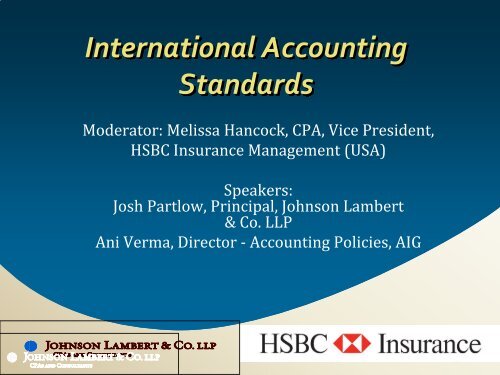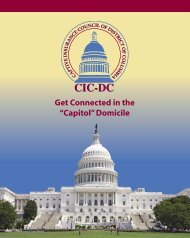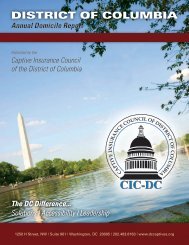International Accounting Standards
International Accounting Standards
International Accounting Standards
- No tags were found...
You also want an ePaper? Increase the reach of your titles
YUMPU automatically turns print PDFs into web optimized ePapers that Google loves.
<strong>International</strong> <strong>Accounting</strong><br />
<strong>Standards</strong><br />
Moderator: Melissa Hancock, CPA, Vice President,<br />
HSBC Insurance Management (USA)<br />
Speakers:<br />
Josh Partlow, Principal, Johnson Lambert<br />
& Co. LLP<br />
Ani Verma, Director ‐ <strong>Accounting</strong> Policies, AIG
2<br />
<strong>International</strong> <strong>Accounting</strong> <strong>Standards</strong><br />
Publicly owned U.S. insurance companies, like companies in any other<br />
type of business, report to the SEC using GAAP. They report to insurance<br />
regulators and the Internal Revenue Service using SAP.<br />
<strong>Accounting</strong> principles and practices outside the U.S. differ from both GAAP<br />
and SAP. But this may change. In 2001 the <strong>International</strong> <strong>Accounting</strong><br />
<strong>Standards</strong> Board (IASB), an independent international accounting<br />
standards setting organization based in London, began work on a set of<br />
global accounting standards, <strong>International</strong> Financial Reporting <strong>Standards</strong><br />
(IFRS).<br />
Ideally, a universal set of accounting principles, IFRS, would facilitate<br />
global capital flows and lower the cost of raising capital.
3<br />
IFRS<br />
Who<br />
IASB, FASB and SEC<br />
What<br />
IFRS is a single set of accounting standards that is rapidly<br />
gaining worldwide acceptance<br />
Why<br />
Global Comparability of Information, Efficiencies in Financial<br />
Reporting<br />
When<br />
Sooner than one might think<br />
How<br />
It depends who you ask!<br />
3
4<br />
IFRS ‐ Key Players<br />
IASB ‐ <strong>International</strong> <strong>Accounting</strong> <strong>Standards</strong> Board<br />
<strong>Standards</strong> are promulgated by the Londonbased<br />
board<br />
FASB ‐ Financial <strong>Accounting</strong> <strong>Standards</strong> Board<br />
FASB is working with IASB to converge standards<br />
SEC ‐ Securities and Exchange Commission<br />
The SEC regulates the use of IFRS for US Public entities<br />
4
5<br />
IFRS ‐ Key Players<br />
• IASB <strong>International</strong> <strong>Accounting</strong> <strong>Standards</strong> Board which issues:<br />
• IFRS <strong>International</strong> Financial Reporting <strong>Standards</strong> – after 2001<br />
• IAS <strong>International</strong> <strong>Accounting</strong> <strong>Standards</strong> – before 2001<br />
• IFRIC <strong>International</strong> Financial Reporting Interpretations Committee<br />
which issues:<br />
• IFRICs Interpretations of the IFRS – after 2001<br />
• SICs Standing Interpretations Committee – before 2001<br />
5
6<br />
IFRS<br />
History<br />
1996 Initiative from SEC to move towards single set of reporting<br />
standards, no significant progress until after 2000<br />
2001 Formation of IASC Foundation and IASB<br />
2002 IASB and FASB announce initiative to achieve compatibility in<br />
financial reporting standards<br />
2003 EU endorses use of IFRS<br />
2005 Europe – 7,000 businesses in 25 countries switch to IFRS***<br />
2006 IASB and FASB agree on roadmap for GAAP/IFRS convergence<br />
2007 Brazil, Canada and Japan establish timelines to adopt; US SEC<br />
removes reconciliation requirement for non US countries<br />
reporting under IFRS Israel, Malaysia and Mexico to adopt IFRS;<br />
SEC publishes roadmap for IFRS adoption<br />
2009 SEC Roadmap comments received<br />
***12,000 companies in 100 countries currently use IFRS<br />
6
7<br />
IFRS<br />
On August 27, 2008, the SEC issued a proposed “Roadmap” for US issuers<br />
to transition to reporting under IFRS. Proposed timeline under the SEC<br />
Roadmap is as follows:<br />
2009 Comment Period Deadline for Roadmap<br />
2010 Early Adopters – Top 20 by Market Capitalization<br />
2011 SEC Votes on Adoption<br />
2012 Effective Conversion Start (if adopted)<br />
2013 Large Accelerated Filers<br />
2014 Accelerated Filers<br />
2015 Remaining Smaller Companies<br />
7
8<br />
IFRS ‐ Characteristics<br />
Principles based (IFRS) vs. Rules based (GAAP)<br />
IASB Framework:<br />
Establishes the thread of the <strong>Standards</strong><br />
Based on definition & recognition criteria of accounts<br />
Compliance with IFRS includes:<br />
<strong>Standards</strong> ‐ 41 IASs, 29 in effect, and 8 IFRSs<br />
Interpretations ‐ 33 SICs, 11 in effect, and 18 IFRICs<br />
IAS Hierarchy in order to interpret guidance<br />
Alternative accounting treatments increasingly being eliminated<br />
Regulators enforce compliance, not IASB<br />
8
9<br />
Current IFRS<br />
Current Relevant Guidance for Insurance Companies:<br />
IAS 18<br />
IAS 37<br />
IAS 39<br />
Revenue Recognition<br />
Provisions<br />
Financial Instruments<br />
SIC‐12<br />
Consolidation – Special Purpose Entities<br />
IFRS 1<br />
IFRS 4<br />
IFRS 7<br />
First Time Adoption of IFRS<br />
Insurance Contracts<br />
Financial Instruments: Disclosures<br />
9
10<br />
IFRS<br />
Principles based (IFRS) vs. Rules based (GAAP)<br />
Principles based standards:<br />
Developed from conceptual framework<br />
Management required to apply judgment/expertise<br />
Spirit of the standard<br />
Economic reality and substance of the transaction<br />
Rules based standards:<br />
Strict rules that must be adhered to<br />
Some choices on presenting the transaction<br />
May structure transaction to comply with rules<br />
Complex and detailed<br />
10
11<br />
IFRS –Open Items<br />
Open Items<br />
Specified Transition Date<br />
IFRS Lacks Detailed Rules<br />
Standard Setting is responsibility of non‐US organization<br />
Protecting U.S. Interests<br />
Convergence or Adoption<br />
11
12<br />
IFRS –Open Items<br />
Open Items<br />
Agreement on Key Principles<br />
IFRS Due Date<br />
• Revenue Recognition 2011<br />
• Insurance Contract 2011<br />
• Financial Instruments (IAS 39 replacement) 2010<br />
• Financial Statement Presentation 2011<br />
• Liabilities (IAS 37 amendment) Q4 2009<br />
• Leases 2011<br />
• Post Employment Benefits (incl. Pension) 2011<br />
• Income taxes 2010<br />
• Financial Instruments with characteristics of equity 2011<br />
12
13<br />
IFRS<br />
IFRS 1 –First Time Adoption of IFRS<br />
Public companies ‐ to report 3 years comparative at<br />
12/31/14, the change will require re‐statement of all prior<br />
years in order to get beginning balance at 01/01/12–<br />
2 sets of books!<br />
13
14<br />
IFRS<br />
Significant differences between IFRS and US GAAP<br />
Consistency of <strong>Accounting</strong> Policies – required for similar<br />
transactions<br />
Consolidation – based on control, off‐balance sheet items now on<br />
balance sheet<br />
Income Taxes – No valuation allowance, Timing of<br />
measurement<br />
Impairment – No 2‐step test, reversals allowed<br />
Disclosures more substantial under IFRS<br />
Disclosure of management compensation<br />
14
15<br />
IFRS<br />
Significant differences between IFRS and US GAAP (cont.)<br />
Revenue Recognition ‐<br />
Limited guidance in IAS 18<br />
GAAP guidance highly detailed, industry<br />
specific<br />
IFRS may reduce revenues for some<br />
Provisions –<br />
Discounting required<br />
Self‐insured liabilities may be affected<br />
May have liabilities under IFRS & not GAAP<br />
Financial Instruments classified as liabilities –<br />
principles‐based definitions of liabilities and equity<br />
15
16<br />
IFRS 4 –Phase I<br />
Insurance Contracts Project Started in 1997<br />
IFRS 4 – Phase I – Limited improvements to current accounting; interim<br />
standard<br />
IFRS 4 –Phase II – Redefines measurement of insurance liabilities (fair value)<br />
Applies to both insurance and reinsurance contracts<br />
Does not apply to other assets and liabilities of an insurer<br />
Move away from the deferral and matching (P & L) approach<br />
Move to an asset and liability approach (Balance Sheet)<br />
16
17<br />
IFRS 4 ‐Phase I<br />
• Interim Standard – focuses primarily on disclosures and<br />
classification of insurance contracts<br />
• Introduces a definition for an insurance contract based significant<br />
insurance risk<br />
• Exempts insurers from changing their accounting policies to<br />
comply with IFRS Hierarchy to limited required changes to<br />
existing accounting practices for insurance contracts and extensive<br />
disclosures<br />
• Refers back to local GAAP in Phase I for items not yet determined<br />
17
18<br />
IFRS 4 –Phase I<br />
Insurance Contract –<br />
“a contract under which one party (the insurer) accepts significant<br />
insurance risk for the other party (the holder of the policy), agreeing to<br />
compensate the policyholder if an event occurs uncertain future (the<br />
insured event) that affects adversely on the policyholder insurance”<br />
Excludes Financial Risk<br />
No quantitative guidance for assessing the significance of insurance risk<br />
– Probability<br />
– Magnitude<br />
18
19<br />
IFRS 4 –Phase II<br />
May 2007: IASB published a Discussion Paper (DP) “Preliminary Views on<br />
Insurance Contracts”<br />
– Issues addressed in the DP:<br />
• Current Exit Value approach (CEV)<br />
• Single approach for life and non‐life insurance contracts<br />
• Risk Margin Assumptions<br />
• No locking of assumptions/”Unlocking”<br />
• Discount rate<br />
• Incorporating assumptions of premiums based on guaranteed insurability<br />
• Estimating cash flows based on market participant view<br />
• Possibility of recognition of gains and losses at inception<br />
• Use of entity’s own credit standing<br />
• Acquisition costs to be expensed, no deferral allowed<br />
19
20<br />
CEV Model Building Blocks<br />
• Explicit, unbiased, market‐consistent, probability<br />
weighted and current estimates of the contractual<br />
cash flows<br />
• Current market discount rates that adjust the<br />
estimated cash flows for the time value of money<br />
• An explicit and unbiased estimate of the margin that<br />
market participants require for:<br />
• Bearing risk (a risk margin); and<br />
• Providing other services ( a service margin)<br />
20
21<br />
IFRS 4 –Phase II<br />
Recent discussions (July 23, 2009 meeting) and current challenges:<br />
– IASB not conclusive on issues<br />
– Will reserves be valued at Current Fulfillment Value (CFV) or Current Exit<br />
Value (CEV)<br />
– Differences exist between IASB and FASB, for example, IASB and FASB<br />
both in favor of CFV but currently debating certain points:<br />
• FASB – Service margin is already factored into liability estimate included in<br />
PV Cash flow and premium determination. Risk margin is a exit value concept<br />
and not CFV<br />
• IASB – Risk margin needs to be included or you are not accounting for<br />
expected variability<br />
• FASB: DFV is entity specific and does not require market participant views<br />
• IASB: More in favor of a modified IAS 37 approach that includes elements of<br />
market participants views.<br />
21
22<br />
IFRS 4 ‐ Phase II: Recent Discussions<br />
Comparison of Current Fulfillment Value (CFV) with CEV<br />
• CFV = “the present value of all expected cash flows that the insurer<br />
anticipates over the life of the contract, taking into account the most<br />
relevant and reliable available market and entity specific information”<br />
• CFV would use entity specific cash flow estimates for factors not<br />
observable in the market (e.g. expense rates) and market consistent<br />
estimates for factors observable in the market (e.g. interest rates)<br />
• CFV would not consider entity’s credit characteristics<br />
• CFV criticized for the use of entity specific information and lack of<br />
clarity over principle of risk margin in CFV model<br />
22
23<br />
IFRS 4 ‐ Phase II: Recent Discussions<br />
Other items under discussion:<br />
• If you include a risk margin is it adjusted each reporting period<br />
• If you have reserve development does it go against risk margin<br />
first and than to P&L<br />
• How should positive cash flow be brought into earnings<br />
• Should Cash flow and presentation be gross or net<br />
23
24<br />
IFRS 4 ‐ Phase II: Recent Discussions<br />
• Unearned premium model ‐ could be used for short duration<br />
contracts<br />
• Policy holder behavior and contract boundaries ‐ “Look<br />
through approach” – i.e. treat cash flows subject to renewal and<br />
cancellation as part cash flows<br />
• Revenue recognition ‐ link between the revenue recognition<br />
project and the insurance contract project is not clear<br />
• Field test ‐ aim is to target 15 insurers for field test<br />
24
25<br />
IFRS 4 ‐ Phase II: Current Challenges<br />
Policy Acquisition Costs:<br />
• Consensus that it should be expensed upfront<br />
• More unanswered questions:<br />
– Should you allow income recognition upfront to offset expense<br />
– Should it be considered in the PV Cashflow<br />
– Rights for future annual premiums<br />
Revenue Recognition Discussion Paper:<br />
• Onerous contracts – Insurance policies fall into this definition<br />
• Revenue DP says you determine on a contract by contract basis. FAS<br />
60 currently allows for determination by line of business.<br />
• Emphasis on one revenue recognition standard could eliminate<br />
Insurance specific standard. Why is insurance any different than other<br />
industries<br />
25
26<br />
IFRS 4 ‐ Phase II: Current Challenges<br />
IAS 37, Liabilities<br />
• Need to align the insurance contract project with the IAS 37 amendment<br />
project<br />
• Insurance liabilities should be measured based on the amount that the<br />
insurer shall rationally pay to relieve the liability. The margin should be<br />
calibrated such that there is no one day loss or gain.<br />
26
27<br />
IFRS ‐ Impact of Changes<br />
• Rating Agencies – Currently most rating agencies support the<br />
change to IFRS<br />
• Regulators<br />
• NAIC – would need to adjust IRIS and RBC measurement tools to<br />
ensure measures are fair to IFRS and US GAAP reporting entities.<br />
• NAIC – will Statutory standards be adjusted to mirror IFRS<br />
• SEC – Prefer change ‐ Need for consistent reporting across industries<br />
and geography<br />
• IRS – If NAIC adopts changes to NAIC annual statement will IRS Forms<br />
follow suite or will we need to reconcile back to IRS format<br />
• Reduces the comparability of financial statements among<br />
companies:<br />
• Measurement could be overly subjective.<br />
• Reduces transparency.<br />
• Introduces undue volatility into the financial statements<br />
27
28<br />
IFRS ‐ Impact of Changes<br />
• Systems and Controls<br />
• IT systems will need to be changed to allow necessary data to be<br />
captured and processed<br />
• Companies will need to implement new controls to ensure they can<br />
meet the requirements of the IFRS standards<br />
• Auditing <strong>Standards</strong> on Internal Control<br />
– Sox and non‐public Auditing <strong>Standards</strong> are still relevant<br />
– Will place additional emphasis on transition process of transition to IFRS<br />
• Convergence Vs. Adoption<br />
– Convergence of GAAP toward IFRS over time may allow changes to be implement<br />
prospectively<br />
– Adoption of IFRS would require restatement of all years presented<br />
– Balancing benefit of consistence with cost of implementation<br />
• Staff training on IFRS<br />
• Performance evaluations and incentive plans<br />
• Costly to implement<br />
28
29<br />
IFRS ‐ Impact of Changes<br />
• Aspects Affecting Captives<br />
• Capital requirements – Letters of Credit and other alternative<br />
forms of capital may not meet IFRS requirements<br />
• Financial statement format – Should regulators currently<br />
allowing GAAP Statements allow IFRS<br />
• Consolidation –<br />
– Will captive transactions with Parent be eliminated in consolidation<br />
– What if there is a fronting company involved<br />
• Captives with investments in affiliates should consider impact of<br />
– Consolidation standards ‐ Equity method vs consolidation<br />
– Revenue recognition standards – will royalty arrangements or other sale and<br />
lease back transactions be effected<br />
29
30<br />
Solvency II<br />
Solvency II (SII)<br />
The aim of EU solvency rules is to ensure that insurance undertakings<br />
are financially sound and can withstand adverse events, in order to<br />
protect policyholders and the stability of the financial system as a<br />
whole.<br />
Sll rules stipulate minimum amounts of financial resources for<br />
insurers.<br />
Sll will introduce economic risk‐based solvency requirements in EU,<br />
more sophisticated than in the past.<br />
30
31<br />
Solvency II<br />
Solvency II (cont)<br />
Framework will consist of three main ‘pillars’ of regulation<br />
Pillar 1 consists of the quantitative requirements – how much<br />
Pillar 2 requirements for the governance, risk<br />
management and supervision of insurers,<br />
Pillar 3 is on supervisory reporting and transparency requirements.<br />
31
32<br />
Solvency II<br />
IFRS on Insurance and SII differences:<br />
IFRS:<br />
SII:<br />
IFRS:<br />
SII:<br />
IFRS:<br />
SII:<br />
IFRS:<br />
SII:<br />
applies to insurance contracts<br />
applies to "regulated products" (may not be insurance<br />
contracts)<br />
Risk margin to be based on market consistent principles<br />
Risk margin is based on cost of capital approach<br />
Takes future cash flows only if certain conditions are met<br />
Takes all cash flows in a contract, e.g a 25 year contract<br />
Discounting basis is the risk free rate as per the DP<br />
Use of swap rate (market rate should be calculated to match<br />
the currency, duration and liquidity of the cash flows)<br />
32
33<br />
IFRS ‐ Challenges<br />
New challenge for consistency of Fair<br />
Value definition under:<br />
IFRS,<br />
US GAAP,<br />
European Solvency II,<br />
Economic Capital,<br />
Principles Based Reserving!!!!<br />
33






